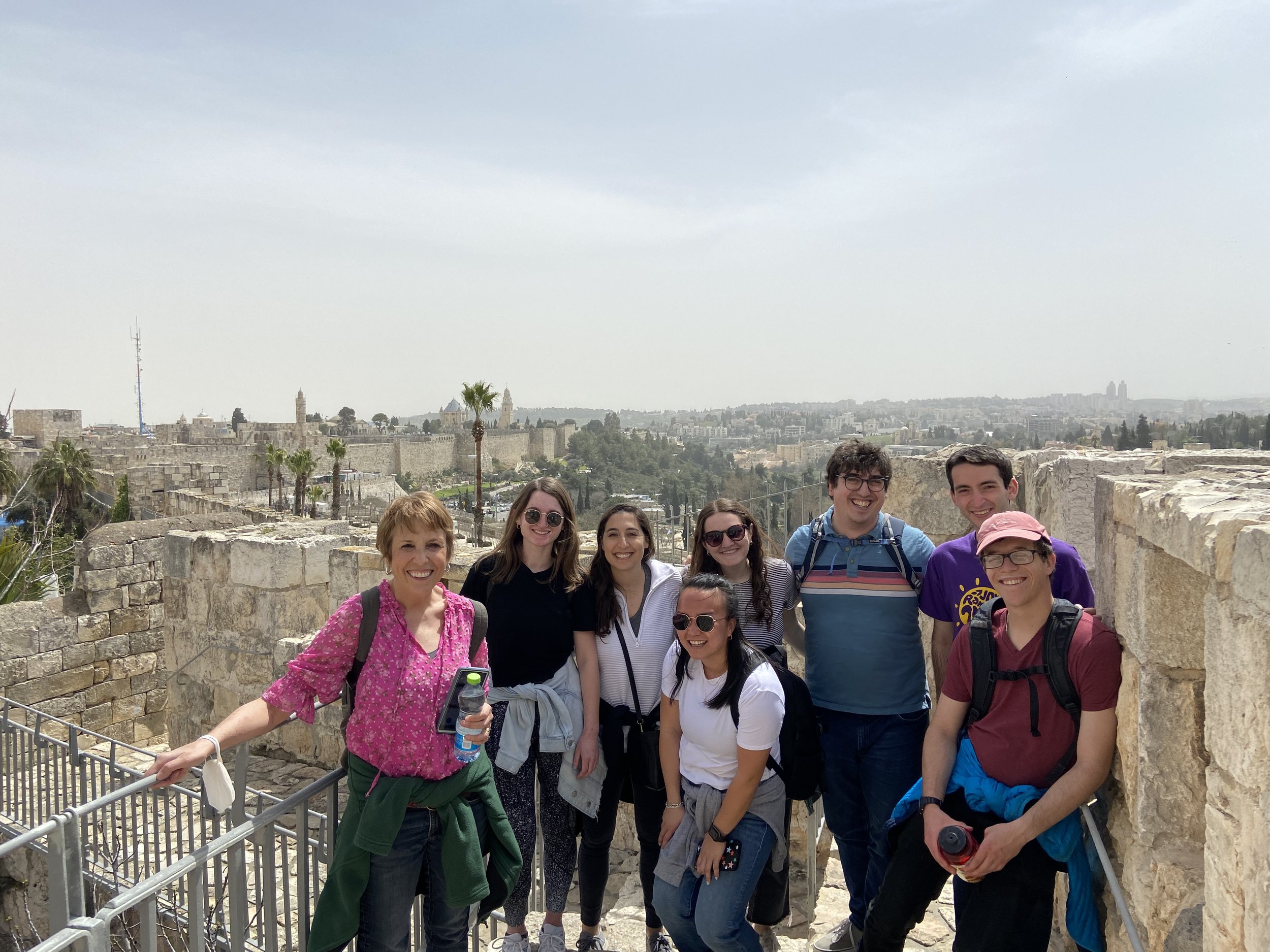Jewish Peoplehood from Theory to Practice: Kerem Trip to Israel
by Daniel Olson, Director of Strategic Initiatives and Research, National Ramah Commission
After more than two years of gathering only on Zoom, the Kerem cohort of young professionals working full-time for Ramah camps finally met again in person. And what a meeting it was. We were fortunate to bring this group to Israel for a week of learning, touring, and welcoming the nearly 350 shlichim and shlichot coming to work at Ramah camps this summer.
Kerem participants enjoy Ethiopian food in Jerusalem
The overarching theme of our experience together was Jewish peoplehood, at many different levels. It started with strengthening relationships among our group. We connected over hummus and Ethiopian food, on long walks around Jerusalem and Tel Aviv, and when we swapped suggestions about what Israeli snacks to purchase for Camp Time sessions with shlichot and shlichim at Kibbutz Shefayim.
Paul Horvath, Program Coordinator at Ramah Nyack, explained why it was important to gather this group in person: “I think most of Kerem started their jobs during COVID. None of us had been together before, so it was really incredible to be together for the first time and to be in Israel for the first time since before COVID. Something like this really can’t happen on Zoom.” Allison Sherman, Program Coordinator at Ramah Darom, added, “The Kerem trip has been magical. It’s been so much fun to connect with my peers, share stories about camp, and learn about some of the awesome things happening in Israel.”
Kerem cohort at the Shalom Hartman Institute
The “awesome things” we saw in Israel connected to Jewish peoplehood. We began our time together at the Shalom Hartman Institute, where we got a preview of some of the learning our Maslul Yisrael Fellows will experience in a few weeks. Shira Ben-Simon Schonfeld, the director of Hartman’s Hevruta gap-year program, led us through a powerful shiur (lesson) about how we interpret the nature of our relationships with people different from us, including fellow Jews from distant communities. Are we family? Partners? Investors? Or merely consumers? It grounded us before we took on the task of getting hundreds of Israelis ready to join our camps this summer.
We visited the headquarters of the World Zionist Organization and ANU, the newly renovated Museum of the Jewish People. Jewish peoplehood was front and center at each site, with representatives explaining changing Israeli attitudes towards both the internal diversity of Israeli society and the value of Jewish communities outside of Israel. A highlight was seeing multiple photos of Ramah as part of the museum’s display on Conservative Judaism!
Perhaps the most moving story of Jewish peoplehood we encountered on our trip was at the Schechter Institutes in Tel Aviv, a combination synagogue-art gallery-cafe on the border between vintage Neve Tzedek and funky Florentin in South Tel Aviv. Rabbi Irina Gritsevskaya talked about her work supporting the Masorti Jewish communities in Ukraine, including traveling to Chernivtsi in western Ukraine to celebrate Purim with Jews from that community and with those who had evacuated from other parts of the country. She explained what it was like to see Jewish humanitarian groups from around the world on the Ukrainian border, showing up to take care of refugees. She told us about the Ramah-Yachad summer camp that Rabbi Gritsevskaya leads in Ukraine and its uncertain plans for this coming summer. Hearing these stories was at once sobering and inspiring.
Kerem cohort on the Ramparts Walk in the Old City of Jerusalem
It was also sobering to walk with Kerem participants on the ramparts over the Christian and Muslim quarters of the Old City and to look down onto the vibrant street life of East Jerusalem. It was an important reminder that multiple peoples share this special place. While we enjoyed seeing ordinary scenes of children walking home from school and playing soccer, we discussed the tensions and challenges of what it means to be a people alongside others.
By the time we arrived at Kibbutz Shefayim for the long weekend of training, the Kerem participants were primed to take what we had learned about Jewish peoplehood during our travels and apply it to important, real-life work. They walked into Shefayim feeling motivated to help these young Israelis from many walks of life start to feel comfortable in our camp communities. In addition to welcoming Israeli staff, they also greeted 70 teens from NOAM—the Masorti youth movement in Israel—who will be campers at many Ramah camps this summer.
Kerem participants set up for Kabbalat Shabbat
Kerem participants, alongside many of the Ramah directors and cherished partners from the Jewish Agency, guided shlichim and shlichot through camp schedules, taught them songs and cheers, and explained the core values of each camp. They taught some of the basics of programming, camper care, and inclusion. They stayed up late with the shlichot and shlichim and swapped stories about their lives, interests, and identities.
They prepared these young Israelis to adjust to the religious life of camp. Nearly all shlichim and shlichot come from either chiloni (secular) or dati (traditional religious) backgrounds. Most have no hands-on experience with Conservative Judaism or egalitarianism in religious life. So when Kerem cohort member Adina Scheinberg, Program Associate at National Ramah and a Berkshires rosh edah, put on her tallit and led Friday night Maariv with her clear, powerful voice, it introduced most of the new shlichim and shlichot to a new way of practicing Judaism.
Many of the shlichot spoke with Adina after Maariv about how they’d like to try wearing a tallit this summer or to learn how to lead prayer. The next morning Talia, a new shlicha from an Orthodox background, took an aliyah to the Torah for the first time. While she isn’t sure if she would do it again, she was glad that she tried it.
All of these reactions are welcome at Ramah, and it was gratifying to see the shlichot and shlichim already demonstrating an open attitude to different approaches to Judaism. We emphasized to them that everyone at Ramah—Israelis, North American staff, and campers—all try on new ways of being and doing Jewish at camp, and that trying is a value in and of itself. The Kerem participants who began this journey with the shlichim and shlichot are well positioned to continue supporting both Israeli and American staff as they learn to work with the other to become partners, even family, at Ramah this summer.
Kerem participants and group leaders from the Jewish Agency prepare to welcome shlichim and shlichot
Sami Eisen, Program Director at Ramah Canada, summed up why it was important for Kerem to attend the training at Shefayim: “The shlichim and shlichot got to see that we don’t just exist behind a screen, but that we’re actual people. That gives them the opportunity to make connections, get their questions answered, and feel like they’re being heard before they cross oceans to join us at camp this summer.”
Kerem participants departed Israel enriched with people: the other members of the cohort, the Ramah directors with whom they worked closely leading the training, and with the many shlichim and shlichot who have already become part of Ramah.






